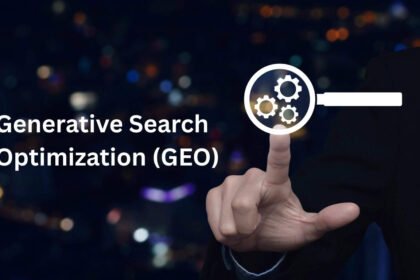Understanding Generative Search Optimization
Generative Search Optimization (GEO) is an innovative approach that adapts search engine optimization strategies to use generative artificial intelligence models. This methodology plays a crucial role in modern SEO practices by enhancing the understanding of user intent behind search queries. Traditional SEO often relies on keyword matching and basic analytics, whereas generative search optimization utilizes advanced algorithms to analyze user behavior and preferences, allowing for a more nuanced interpretation of what users are truly seeking.
The fundamental difference between generative search optimization and conventional SEO lies in the latter’s focus on static optimization techniques. While traditional methods often depend on predetermined keywords, generative search optimization proactively generates high-quality, relevant content tailored to meet evolving user expectations. By leveraging AI models, content can be crafted with a deeper understanding of contextual nuances, thereby increasing its relevance and effectiveness in response to user queries.
As digital landscapes become increasingly competitive, the importance of adopting generative search optimization becomes evident. Search engines are consistently improving their algorithms to favor content that aligns with user intent rather than simply matching keywords.
This shift in focus necessitates that businesses rethink their SEO strategies to incorporate generative approaches. By using generative AI to analyze trends and generate optimized content, organizations can stay ahead of competitors who continue to rely solely on traditional SEO practices.
In essence, generative search optimization represents a paradigm shift in how online visibility is achieved. By prioritizing user intent and producing content that resonates on a deeper level, businesses can enhance their search performance and deliver a better user experience, responding effectively to the demands of a dynamic digital marketplace.
What are Key Components of Generative Search Optimization
Implementing generative search optimization in an SEO strategy requires a multifaceted approach that encompasses several critical components. One of the primary elements is the utilization of AI-driven content generation tools. These tools, such as OpenAI’s GPT models, enable marketers to produce high-quality, relevant content at scale.
By leveraging machine learning algorithms, businesses can analyze user intent and create tailored content that resonates with their target audience. Employing these technologies ensures that content remains engaging and informative, catering to the evolving landscape of search behavior.
Keyword research methodologies play an integral role in successful generative search optimization. It is essential to identify a mixture of primary and long-tail keywords that reflect user queries.
Modern approaches involve semantic keyword analysis, where tools like SEMrush or Ahrefs can unearth related terms and phrases that increase a site’s visibility in search results. This approach complements traditional keyword strategies and aligns with the intent-driven focus of generative search engines.
Role of NLP
Natural Language Processing (NLP) applications are equally essential as they facilitate a deeper understanding of user search queries. NLP allows search engines to comprehend context, which improves the accuracy of search results and relates to semantic search principles. It interprets nuances in language, enabling the delivery of results that meet user expectations more effectively.
Furthermore, factors contributing to user experience, such as mobile-friendliness and site speed, have emerged as pivotal in optimizing content for generative search. Websites must be responsive and load quickly to retain users, as these aspects influence search rankings significantly.
For eg, Google’s Core Web Vitals offers insights on performance metrics that impact user satisfaction. Implementing tools like Page Speed Insights can help identify performance issues and optimize accordingly.
In conclusion, the integration of AI tools, advanced keyword research methodologies, NLP applications, and a strong focus on user experience are key components to successfully incorporating generative search optimization into an SEO strategy. Each element contributes to creating a robust online presence that meets contemporary search demands.
Strategies for Integrating Generative Search Optimization
Integrating generative search optimization into existing SEO frameworks requires a strategic approach that harmonizes content creation efforts with AI insights. To begin, organizations must facilitate collaboration between content teams and data specialists.
This can involve regular workshops where teams discuss current trends in generative AI, review performance metrics, and brainstorm ways to leverage these insights for content development.
By aligning the objectives of content creators with the capabilities of generative AI technologies, companies can enhance the quality and relevance of their output.
Furthermore, adopting a data-driven approach to content strategy is crucial. Marketers should utilize analytics tools to monitor audience behavior and engagement metrics. This data can inform the types of content to prioritize, as well as the language and formats that resonate most with users.
Continuous testing and iteration of content based on these metrics help in refining strategies and enhancing the overall effectiveness of SEO efforts. Experimenting with diverse formats, such as blogs, videos, and infographics, allows teams to discover which approaches generate better results and drive higher engagement.
Training teams on the use of new generative AI technologies will also be essential. Regular training sessions can equip team members with the skills necessary to leverage these tools effectively while promoting a culture of experimentation.
Encouraging teams to not only embrace innovative technologies, but also to maintain a balance between user-centric content and algorithm-friendly strategies, will yield optimum results in the long run.
By focusing on the deployment of generative search optimization and continuously adapting based on user feedback, organizations can enhance their SEO performance and stay competitive in the evolving digital landscape.
Measuring Success and Adjusting Strategies
To effectively measure the success of generative search optimization within your SEO strategy, it is vital to establish a framework of key performance indicators (KPIs). These performance metrics serve as benchmarks that provide insight into how well your optimization efforts are performing.
Key areas of focus should include organic traffic, user engagement metrics, and conversion rates. Each of these elements plays a crucial role in assessing the effectiveness of the generative search optimization initiatives.
Organic traffic is the primary indicator of how well your content is ranking in search engine results. A sustained increase in this traffic not only signifies successful optimization efforts but also indicates that your content is resonating with users.
Monitoring trends in organic traffic can help identify which pages are performing well and which may need further refinement. Additionally, tools such as Google Analytics can provide valuable data on user behavior, allowing for a deeper understanding of traffic sources and visitor retention rates.
User engagement metrics, including average session duration, pages per session, and bounce rate, are also essential for measuring the effectiveness of generative search optimization. These metrics indicate how well users interact with your content and the overall user experience on your site. High engagement levels suggest that users find your content relevant and valuable, which is crucial for improving conversion rates.
Closing thought
Finally, conversion rates represent the ultimate goal of your SEO strategy. Whether it is signing up for a newsletter, purchasing a product, or filling out a contact form, tracking conversion rates provides insight into the effectiveness of your overall SEO strategy.
Regularly analyzing these metrics allows marketers to adapt their strategies based on data-driven insights, ensuring that their approach aligns with shifts in search engine algorithms and evolving user behavior. Continuous refinement of your tactics will establish a robust SEO strategy that embraces generative search capabilities.








